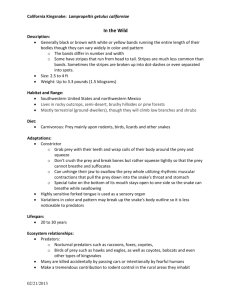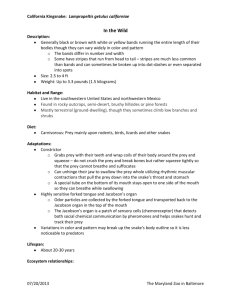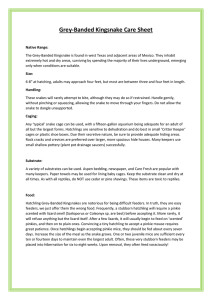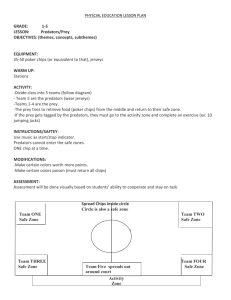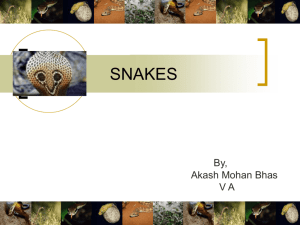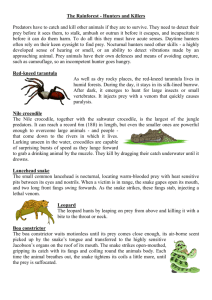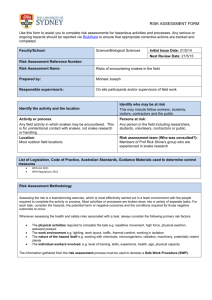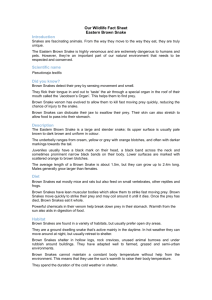In the Wild - The Maryland Zoo in Baltimore
advertisement
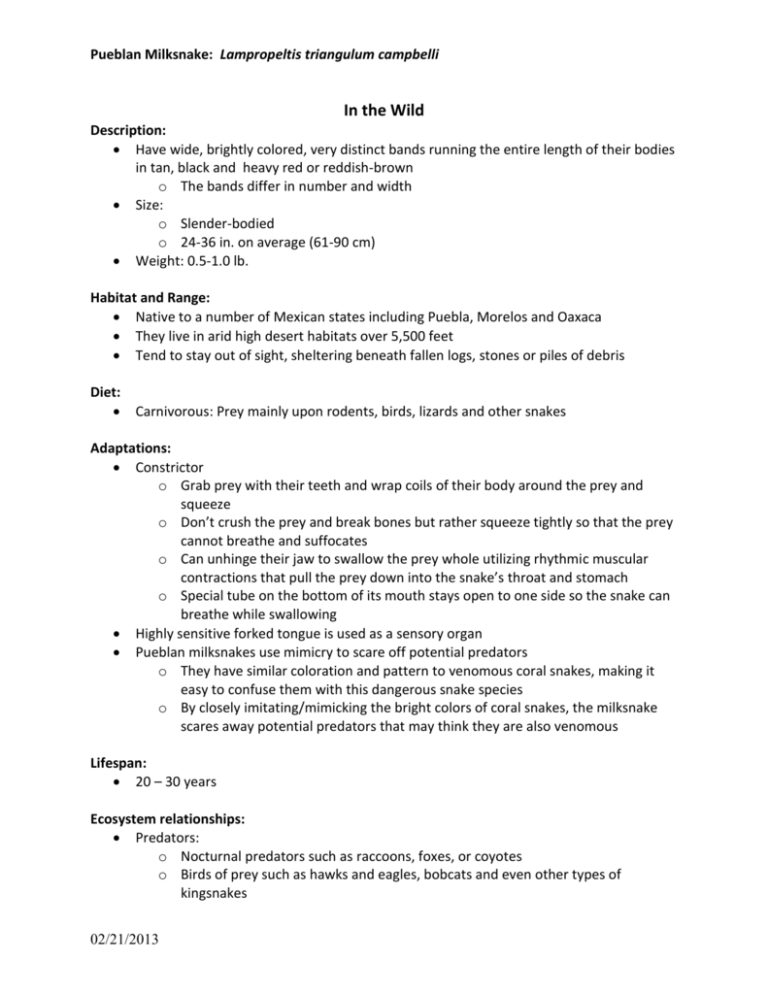
Pueblan Milksnake: Lampropeltis triangulum campbelli In the Wild Description: Have wide, brightly colored, very distinct bands running the entire length of their bodies in tan, black and heavy red or reddish-brown o The bands differ in number and width Size: o Slender-bodied o 24-36 in. on average (61-90 cm) Weight: 0.5-1.0 lb. Habitat and Range: Native to a number of Mexican states including Puebla, Morelos and Oaxaca They live in arid high desert habitats over 5,500 feet Tend to stay out of sight, sheltering beneath fallen logs, stones or piles of debris Diet: Carnivorous: Prey mainly upon rodents, birds, lizards and other snakes Adaptations: Constrictor o Grab prey with their teeth and wrap coils of their body around the prey and squeeze o Don’t crush the prey and break bones but rather squeeze tightly so that the prey cannot breathe and suffocates o Can unhinge their jaw to swallow the prey whole utilizing rhythmic muscular contractions that pull the prey down into the snake’s throat and stomach o Special tube on the bottom of its mouth stays open to one side so the snake can breathe while swallowing Highly sensitive forked tongue is used as a sensory organ Pueblan milksnakes use mimicry to scare off potential predators o They have similar coloration and pattern to venomous coral snakes, making it easy to confuse them with this dangerous snake species o By closely imitating/mimicking the bright colors of coral snakes, the milksnake scares away potential predators that may think they are also venomous Lifespan: 20 – 30 years Ecosystem relationships: Predators: o Nocturnal predators such as raccoons, foxes, or coyotes o Birds of prey such as hawks and eagles, bobcats and even other types of kingsnakes 02/21/2013 Pueblan Milksnake: Lampropeltis triangulum campbelli Many are also killed accidentally by passing cars, and sometimes intentionally by fearful humans Make a tremendous contribution to rodent control in the rural areas they inhabit Reproduction: Breed in late spring and summer Females lay eggs in rotting wood or beneath rocks and logs, where conditions are relatively warm and humid o Lay an average of 10 eggs per clutch, ranging from 6-20 eggs o After laying the eggs, females leave and do not provide any parental care Eggs hatch after 2 months o Each hatchling is only a few inches long when it leaves the egg, looking like a miniature version of the adults o Are more brightly colored at birth than the adults, but their color fades as they mature Activity: Nocturnal Other “fun facts”: The milksnake got its name from the widespread myth that it milks cows at night. They may be seen in barns in search of rodents, but snakes do not drink milk. The Pueblan milksnake is a type of kingsnake o All kingsnakes are native to the western hemisphere o The “king” in their name refers to their willingness to eat other snakes, even venomous ones, including rattlesnakes, copperheads and cottonmouths. Kingsnakes are able to eat venomous snakes because they are highly resistant to their venom. Conservation Status and Threats: They are considered stable and widespread. However, it is important to conserve their habitat to maintain population levels, especially since they are so important for rodent control. Commonly bred for the pet trade At the Zoo Shake hatched in 2010 and was purchased from a dealer as a juvenile in 2011. What We Can Do Make sure you know the origin of the products you buy o Opt for fake leather or snake skin products Do your research before buying a pet 02/21/2013 Pueblan Milksnake: Lampropeltis triangulum campbelli o Make sure you are not purchasing a wild-caught individual. Captive-bred species are often easy to find. o Make sure you know how to properly care for any animal before you decide to buy it as a pet Some things to consider include adequate housing, diet, temperature requirements, and lifespan Some pets also require a lot of time and money to be properly cared for References: http://www.marylandzoo.org/animals-conservation/reptiles/eastern-milksnake/ http://www.sandiegozoo.org/animalbytes/t-kingsnake.html http://www.knoxvillezoo.org/animals_attractions/animal_guide/reptiles/pueblan_milk_snake.aspx http://www.saczoo.org/page.aspx?pid=456 02/21/2013
